With the Performante, Lamborghini has created not only the best Huracan currently on sale, but also a new best-in-class legend.
If you’ve ever been to Italy you will know travelling between its cities is akin to going from one village to another. There are farms next to car dealerships, then it turns industrial for a little bit and back to farmland.
It’s an odd thing to see, but there’s a general sense of history and authenticity to the place that is impossible to replicate. And it’s the home of so many things the world loves, including supercars.
Thankfully for us, we’ve come on a good day. It’s 22 degrees outside, there is not a hint of rain and we are on a bus to a racetrack in Imola to drive the all-new Lamborghini Huracan Performante, which the company considers the fastest road-legal, track car it has ever produced.
The Autodromo Enzo e Dino Ferrari, to give it its full name, is named after the legendary brand's founder and his son, Dino. The irony of coming here in a Lamborghini that is faster – if you take Nurburgring lap times into consideration – than anything Ferrari currently makes, is not lost on us.
The track is very close to Lamborghini headquarters in Sant'Agata Bolognese but we can’t help but feel a sense of intense rivalry between the two brands. Any Ferrari branding usually visible at the track is covered up, everywhere you look.
This is a rather famous racetrack for all the wrong reasons. It has claimed lives over the decades, but it’s best remembered for the death of Formula One legend Ayrton Senna on the Tamburello corner on the first of May 1994 while he was leading the San Marino Grand Prix.
For the Formula One fans amongst us, a little fact mostly lost to the history books is that Senna actually tested a McLaren Formula One car powered by a Lamborghini V12 in 1993 at both Estoril and Silverstone.
This could have been the beginning of an amazing involvement in F1 for Lamborghini, but the company was sold to the Indonesian group MegaTech in 1994, which saw the Italian brand shut down its Engineering department that was in charge of its F1 program. There is currently a Senna exhibition at the Lamborghini museum which is definitely worth checking out.
A lot has changed since then and Lamborghini has been part of the Volkswagen Group since 1998, which has given it the current engineering and R&D budget to be where it is today.
Since Senna’s death, Tamburello corner has changed to become less mortifying – as the Lamborghini test driver explained to us. Previously, it was 22 seconds of throttle flat-to-the-floor, through the corner, and one of the longest ‘flat-out’ corners of any racetrack in the world. It now has a left-right chicane to slow you down.
Even so, the memories of Senna ran through our mind as Lamborghini’s racing instructor explained you take that particular corner in third and squeeze the throttle as you come out of the chicane. There’s a lot to learn here at Imola, and not enough time.
Even so, keys are handed over, a new set of Pirellis are fitted and we begin the walk through the pits to our very own Huracan Performante test car.
From the outside, we see the Lamborghini Huracan Performante as the best design execution of the Huracan family by far. It looks absolutely menacing in any colour it’s presented in, though we especially love it in orange or yellow with the Italian flag running along the side and riding on giant 20-inch gold wheels (245/30 front, 305/30 rear).
It finishes off what the standard Huracan left behind, with very aggressive front and rear active aerodynamic componentry that helps the new Lambo a lot more than just in the looks department.
We jump in and close the door – our car has the bucket sports seats which are actually a lot more comfortable than you probably think, though they are optional. Standard seats for daily use are the more logical choice. In saying that, compared to the Gallardo Superleggera, this car is a luxury cruiser and far more suited to daily use – even by Lamborghini’s own admission.
Strap in and we begin to turn the steering wheel in idle to find out which system is fitted to this particular car. Lamborghini offers a dynamic active steering system (optional) that really tightens up the responsiveness of the steering wheel. Usually, we're not a fan of such systems but as we found out by day’s end, it's worth the additional cost if you intend to track your shiny Lambo regularly.
Broken English comes through the radio and our lead car, a standard Huracan piloted by Lamborghini’s best, begins to move out of the pits, followed by our Performante eager to showcase its new-found prowess and push the regular car to its limit.
Behind us sits the same naturally-aspirated V10 as the car in front, but now producing 470kW of power and 600Nm of torque. That, technically, makes it an LP640-4 (to signify 640hp, 30 more than the standard car), but Lamborghini boss Stefano Domenicali (who was in charge of the Ferrari Formula One team from 2008-2014) told us he got tired of the long names and decided to stick with just Huracan Performante for this one. We agree with his decision.
Combine the extra power and torque with a revised seven-speed dual clutch transmission, and the Performante can now go from 0-100km/h in just 2.9 seconds, 300ms faster than the standard car. That is achieved by pushing more of the torque to the front than before but also modifying the shift software of the DCT. Whatever engineering work went into it, it’s now faster than the turbocharged Ferrari 488 and matches the recently launched McLaren 720S.
But here is the thing, Lamborghini says it's moving away from viewing the power unit as the be all and end all of the car’s performance. Which is why the Performante is all about its active aero. That’s a term that has been used by almost all manufacturers of sports cars, but in Lamborghini’s case, with its patented ALA system, it's very, very different.
The front splitter has air ducts that either open or close (in 200ms) to enhance the braking and acceleration of the hyped up Huracan. So, for example, when the car is accelerating, the air vents are open to allow air to flow, then when the brakes are engaged those ducts close to create more air resistance and push the nose of the car down for better grip into corners, providing downforce just when you need it.
That’s impressive in itself, but it’s that well-placed and aesthetically pleasing (to us, at least) hollow rear wing that has earnt the company accolades for the Performante. The rear wing employs a similar concept of air flow at the front, passing air through and closing veins to aid in acceleration and braking.
However, what it also does is provide aero vectoring.
To explain in simple terms, the wing is divided into left and right air chambers, so for example, when you are turning left, the right side of the wing allows air flow and the left side shuts to create air resistance. Similar in basic theory to how an aeroplane turns by creating air resistance on one side.
With one side of the wing closed, this generates around 50Nm of torque that turns the car left, which aids in better cornering. Lamborghini says it toyed with this same concept for the front spliter as well, but the sudden torque pressure change on the front wheels made it somewhat uncomfortable and unpredictable for the regular driver.
With all the changes, the Performante has 350kg of downforce, or about 750 per cent more than the regular Huracan. According to Lamborghini, that additional downforce and the active aero vectoring made up about 60 per cent of the 30+ second lap difference between the regular Huracan and Performante at the Nurburgring. The rest is the additional power and acceleration out of corners, further aided by the specifically designed Pirelli tyres.
The active aero is always working, regardless of whether it's in Strada (road), Sport or Corsa (track), but the aero vectoring is only ever turned on in Corsa mode. Which is what we had our Performante dialled up to as we begun our track session.
There’s something unique about the Performante as it screams past the 200km/h mark coming down the main straight at Imola.
You know what it is? It’s emotionally gratifying. Very much so. In a way it’s similar to the 458 Speciale at full scream, it tingles a sensation deep inside every car lover that modern turbocharged cars fail to gratify. The noise vibrates through the cabin and up your spine, you can’t hear yourself think but if you could, it would be nothing but thoughts of pure happiness.
The exhaust system of the uprated Huracan has been moved to be centrally mounted, which has seen the entire manifold change to create less back pressure but also a different frequency of noise to the standard car. It’s so f'ing loud, we can’t emphasise this enough, but now it sounds more like a GT3 race car than a road car.
Listening to the cars go past from the pit stop, the regular car sounds excellent, the Performante sounds like it’s possessed by Diablo himself. It begs to be revved hard and with the use of titanium valves in the engine, it can go that extra 200 or so rpm higher than before as well.
The first time we had a full flying lap we found the braking into turn one somewhat terrifying. With close to full force applied dead straight, the Performante moved around under heavy braking from left to right, feeling somewhat unstable. But after a dozen or so full speed laps, we noted it as just a characteristic of the car and with some modification to the braking force application, the trait can be better controlled.
What’s most impressive about the Performante, however, is its forgiving nature. In Sport mode it allows you to get a little sideways before stepping in and stopping any embarrassing moments; in Corsa though, it’s all about performance and on one too many times we tried to force it into understeer (which it will, but at a significantly higher threshold than the regular car) or oversteer and found the car responded in a near perfect manner.
By that we mean it will kick in to stop the rear getting loose, but it seems to never really cut power all that much. It’s – by far – the best calibration of the electric stability control we’ve yet encountered on track, bar the Porsche GT3 RS.
It was around lap five that we felt comfortable with the track and the car to begin really exploiting its potential. We drove cars with dynamic and standard steering systems and we felt the latter to be decent, but lacking precision and directness compared to the optional system. The turn in for the Performante is very natural; you point it where you want to go and with a little finesse, it will get you there without a fuss. It has tremendous grip, a lot of that is from the all-wheel drive system itself.
Lamborghini wouldn’t let us test the Performante back to back with the regular Huracan on track (we suspect that was to avoid embarrassing the standard car too much), which made it difficult to really feel the difference the active aero vectoring and the active aero downforce was making in pushing the car in the right direction and the nose down when braking.
Even so, having spent an awful lot of time behind the wheel of both AWD and RWD Huracans, we can tell you the Performante is, much, much, much, better than its lesser siblings in all dynamically measurable respects. Sorry, Lamborghini.
After a few hours on track and a slightly emptier Pirelli tyre truck, we headed out onto the road to find out what the daily usability of the Performante would be like. Our road car had been abused for 12,000km of hard testing and track evaluations. Even so, it drove without a single bit of vibration or rattle that we have at times come to almost expect from the Italians.
Most importantly, it provided a sense of ride comfort that was uncanny. We got lost halfway through the drive program since we don’t speak Italian and the sat-nav didn’t speak English (though we did realise it now supports Apple CarPlay, much too late) and we ended up on a farmland road designed for trucks and idiots lost in Huracans. We put the nose up and ploughed through like a Lamborghini tractor, never once feeling out of place.
We found dozens of roads that hadn’t been resurfaced since World War II and realised that whatever Lamborghini has done with the Huracan Performante, it’s now more comfortable and far more compliant in its road manners than the regular version.
This is a fact the brand’s head of R&D all but admitted with a smile when questioned. The new calibration of the car’s suspension arms and bushings has led to a much better setup of the extreme ends of road and track use, allowing for the Strada mode to provide levels of comfort you’d never expect from a Lamborghini while keeping Corsa stiff enough to make a meal of any smooth corner.
Overall, it’s hard to keep heaping praise onto the Huracan Performante, but that’s all that we have to give, more and more praise. It’s as near a perfect supercar as you’d expect. It shames the Ferrari 488 for noise and technical achievements (in the aero department, at least) and it shames its own siblings for dynamic competency.
Perhaps, our only criticism is the price, which, although likely to start in the mid $500Ks drive away, will realistically be reaching in the $600Ks by the time you option up the aesthetic and dynamic packages that one really needs when purchasing something as glorious as a Performante. If it wasn’t for the ridiculous options list, this car would be as close to a perfect 10/10 as we’ve ever driven.
Before we finish here, we should note one little thing that made us realise why the Italians will forever continue to produce cars that we love.
At one point during our test drive on deserted village roads on the outskirts of Imola, our convoy of Lambos drove past an Italian police car much, much faster than the apparent speed limit (though, as the lead car of this group, we blame ignorance, for it's hard to see speed limit signs when you’re going that fast).
This gave us a slight momentary fright and visions of Italian prisons and bad pasta, only to be met with thumbs up and massive grins and laughter from the two police officers inside the car.
God bless you, Italy. Keep doing what you’re doing.
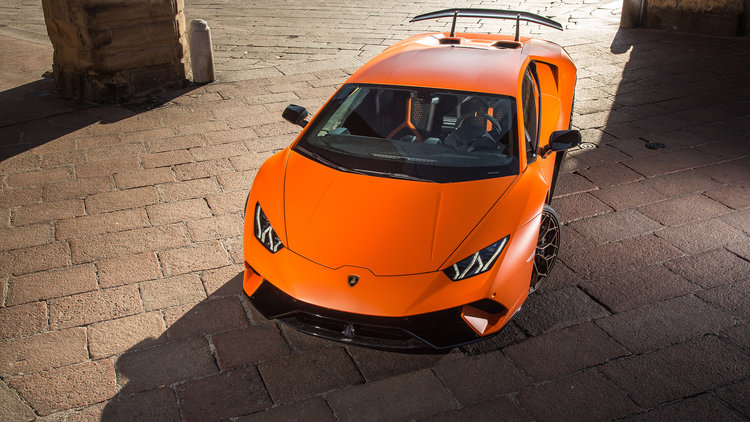
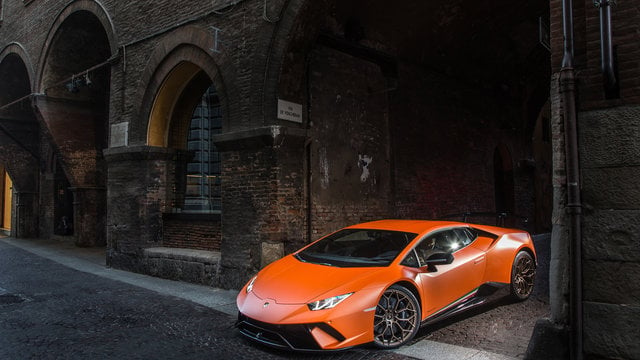
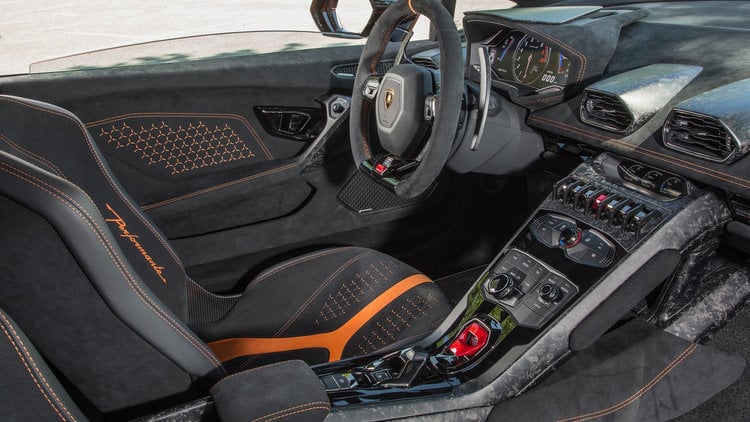
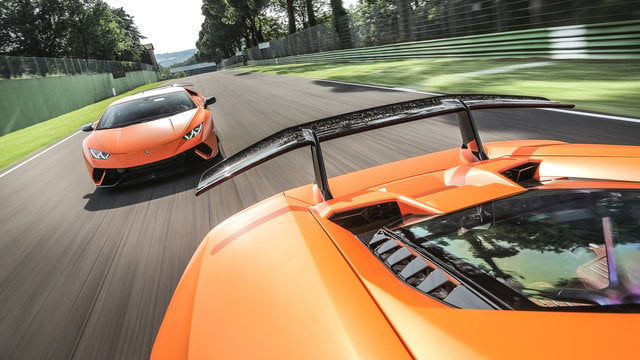
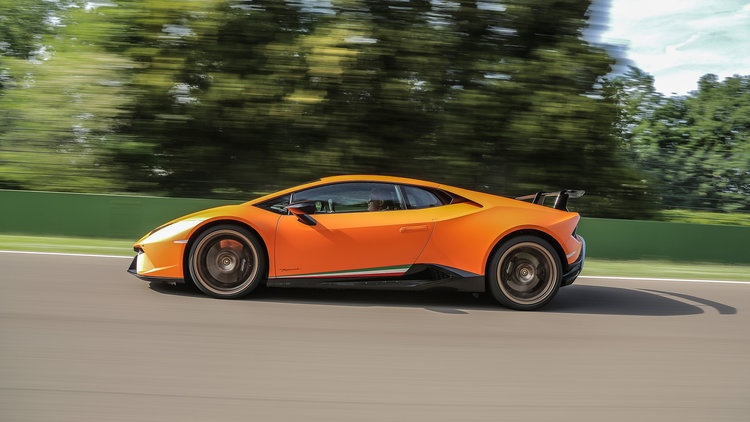
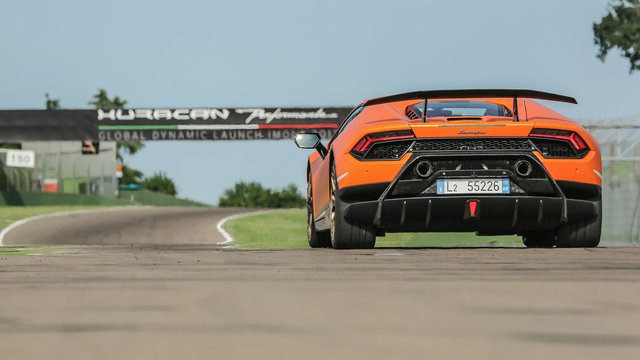

cars for sale online
ReplyDelete